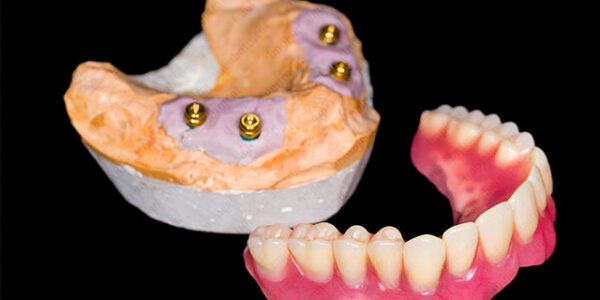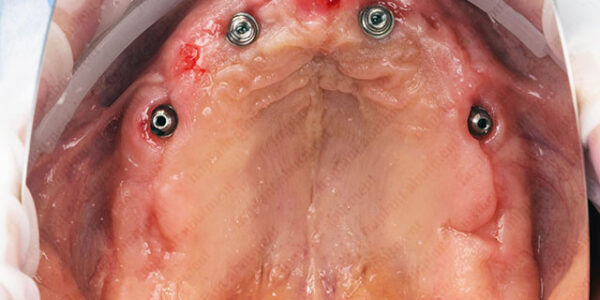Dental implants: Restoring quality of life to millions
Dental implantology has seen impressive advances over the last few decades, and today’s restorations look, feel and function like real teeth more than ever — so much so that patients often can’t tell the difference between their former real teeth and their new restoration. Removable dentures are slowly being phased out and implant-retained systems taking their place, with a marked improvement in patients’ abilities to perform daily oral functions such as chewing, speaking and smiling.
Whether placing implants in a patient who is partially or fully edentulous, and who previously had a form of prosthetic or not, implant-retained prostheses are life-changing and allow the wearer to return to normal oral functions that may have been impeded due to loss of teeth. Thanks to dental implants, patient confidence and quality of life is restored to approximately 15 million Americans each year.
Dental implants have the upper hand when it comes to tooth replacement
The two main alternatives to dental implants are dental bridges and dentures, and they provide a viable alternative for restoration, but come with some significant disadvantages that make them an inferior option to dental implants.
Dental bridges can require adjustments to healthy teeth in the mouth, such as shaving them down, in order to accommodate the bridge installation, making it an inefficient solution in cases where more than two adjacent teeth are missing. All dental bridge types are also quite difficult to keep clean, and require a lot of daily management to maintain a healthy intraoral environment.
Dentures, the second option to dental implants, also require more daily time investment than implant-retained restorations. Not only do they require a daily cleaning regimen, but they take some getting used to in order to successfully carry out such functions as eating and speaking, because they do feel like a foreign object in the mouth, whereas dental implants feel like natural teeth.
Improperly-fitted dentures can lead to functional issues with eating, talking, laughing and smiling, and can loosen with time as facial bone structure shrinks due to lack of stimulation to the jaw, which is a problem remedied with the use of dental implants. Both dental bridge and denture wearers can experience long-term health issues of the mouth due to the lack of bone stimulation, which results in periodic need for replacement.
While initial costs of these two alternatives is lower than the cost of dental implants, the regular need for maintenance and replacement of dental bridges and dentures can make them the more expensive solution over the long haul.
The average cost of dental implants
Dental implants are the best solution for dental restoration, with their impeccable similarity to real teeth, their low maintenance requirements, and ability to last a lifetime. That said, the one major disadvantage to dental implant systems is their cost, which often exceeds what many people can afford, especially when dealing with full mouth dental implants.
Factors that can affect the final bill of the restoration include: the number of implants required, the location in the mouth, material of the implant components used, level of complexity of the procedure, experience of the dental professional performing the restoration, laboratory costs for crown production, and any preliminary procedures that may be required, such as bone grafting. Let’s dental implant restoration costs and common additional procedures and their costs.
A typical implant restoration of a single tooth, comprising the implant, implant abutment, prosthesis and procedure, ranges from $3,000 to $6,000. Common preliminary procedures such as x-rays ($20-$200), CT scans ($200-$1,000), tooth extraction ($75-$700) or bone grafting ($2,000-$3,000) that are necessary are not included in the cost of the restoration, and are therefore not included in this price.
These additional costs range based on the complexity of each procedure and can add from $75 to $5,000 to the final bill, making the potential cost of a single dental implant restoration as low as $3,000, but as exorbitant as $11,000. That said, dental implants should last a lifetime, making them a long-term investment with a high return.
If dental implants are so expensive, how do most people pay for them?
Paying in full can amount to a hefty sum, so we’ve put together a list of ways that the cost of dental implants can be partly or fully paid for.
Dental insurance
Dental insurance companies offer different plans for helping patients cover the cost of their dental care. Some dental companies, for example, will cover half the cost of a dental implant restoration, which saves a great deal of money. It is best to check directly with your dental provider to find out what your options are for implant-retained restorations. However, many people unfortunately don’t have access to dental insurance, and thus getting support from a provider is not an option.
Dental loans
It is possible to take out a personal loan that is specifically intended for costly dental procedures. As with any loan, it is important to explore your options and base your decision on the qualification requirements, annual percentage rate (APR), any additional fees involved, and approval time.
In-house payment plans at your dentist’s office
Some dentists offer an option to pay over an extended period, and each office’s payment plans may differ from the next. It is worth talking to the accounting professionals in your dentist’s office to find out your options for this type of dental loan that is usually paid off over the period of several months or years.
Tried and true inexpensive dental implant restorations
If paying back loans or having access to dental insurance doesn’t seem to be in the stars for you, consider some inexpensive dental implant alternative options that still rely on professional integrity and high-quality materials.
Dentistry Schools
Dentistry schools across the country offer free or reduced-cost dental work to give dental students the experience of working with live patients. Since not all schools offer implant work, it is best to get in touch with your local dentistry school to find out what services and procedures are offered.
Nonprofit support
Across the U.S. there are multiple nonprofits that collect money for those in need of dental care, like Dentistry From the Heart, a widely-dispersed nonprofit that is headquartered in Florida. Getting in touch with your nonprofit of choice is the best way to learn about your eligibility for support.
Avoiding poor quality dental implants
It is important when dealing with any aspect of our health to make sure that we are choosing good quality materials, tools and professionals to carry out these procedures. If chosen improperly, complications can arise down the road that can lead to health problems or perhaps even the need to have the entire procedure performed again.
While looking for affordable solutions is not discouraged, selecting a solution before making sure that you are still getting a good quality product can be an irreversible mistake.
Being aware of the risks of global dental tourism
An increasing trend over recent years has been to go abroad for medical care, particularly to countries where medical care is cheaper. For Americans, countries like Costa Rica and Mexico have become big dental tourism hubs, while western Europeans travel to eastern Europe. Saving money is most always the goal, but the risks that go along with these types of dental services must be acknowledged. Not only is the dentist that placed your implants very far away from where you live should some complications arise down the road, but the cheaper costs of the dental work aren’t only a result of lower labor costs, lower fees and lower costs of living in that country.
More often than not, the countries that host dental tourists are using low-quality implants and implant parts. Not only is this a risk for the components which should stay in your mouth for a lifetime, but your dentist at home may have problems working with and servicing these parts. Should something go wrong with the implant and it break, need to be removed or need to be replaced for any reason, a second surgery can be costly, complicated and potentially damaging to the patient’s health.
Not to mention, doing these procedures far away from home where the performing dental professional is held less accountable than one living closeby is a big risk. It’s better to stick with working with a dental office or company you can trust and that doesn’t require a passport to get an appointment.
This way, you can return to your dental professional for the necessary checkups and maintenance that are recommended, and have someone to go to should you experience any post-surgery complications. Remember: dental implantology takes a lot of training and experience to perform it well. It’s important that you can trust your dental technician, prosthodontist or dentist.
Implant dentistry is a changing market: Keeping up with the times
Dental implantology is rapidly increasing in popularity and as a result so too is the market that’s manufacturing dental implant systems and their components. In this current competitive climate, many companies are rising up with affordable alternatives to the market’s current leaders.
For example, there are online-based dental implant manufacturers making high-quality implants and components that are compatible with the market’s leading brands. While some are saving money by using lower quality materials, there are others that are making top-end products that rival their leading competitors, and some are even pushing the envelope by having powerful R&D teams that are patenting groundbreaking new designs.
Dentists that are sourcing these high-end but more affordable companies are making a high quality restoration more affordable for their patients; just make sure to find out where your dental professional is cutting costs and if it’s happening in the right places. Quality of materials and manufacturing process should never be sacrificed.
The takeaway
While dental implant restorations are a costly up-front procedure, this long-term investment has some serious return on investment, both financially and with regard to quality of life.
As not all patients have the luxury to pay for these procedures in full, there are a number of options which financially assist or subsidize the restoration. It is important to maintain proper dental health, because the health of our teeth affects the health of our entire body — from our gut to our heart to our mental health.





